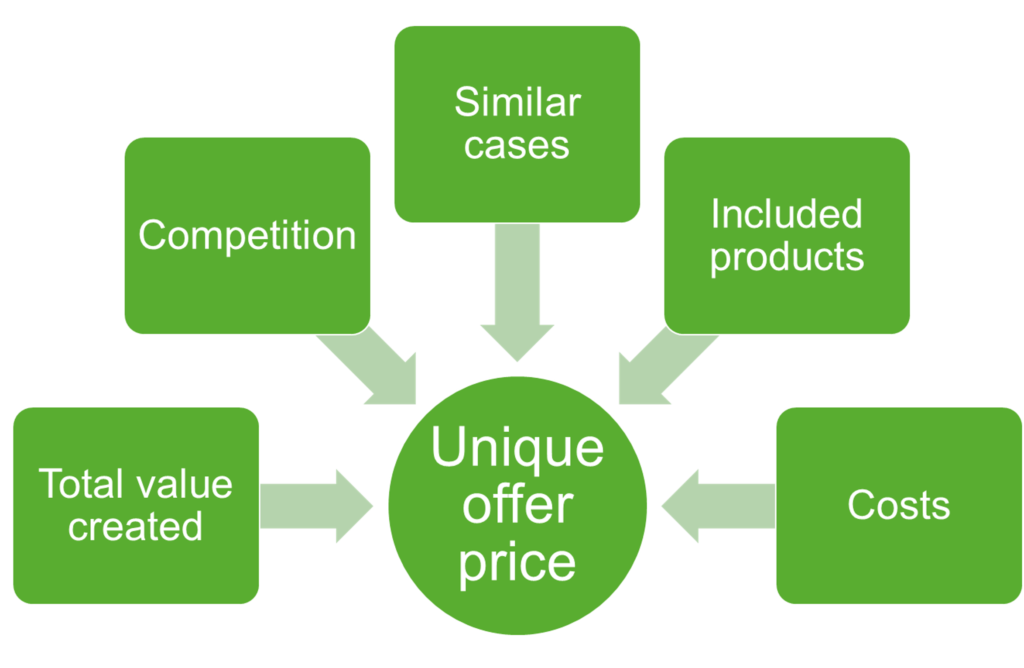
One of the trickiest areas in B2B pricing is the decision on a price for infrequently purchased items. This can be projects, customised products, services, or other unique customer-specific offers.
When dealing with these cases, the most common approaches to pricing – for example defining a value-based price per product using historical data to reach an optimal price – do not produce the best results. To succeed in the best possible way, particularly during these trying times, increased pricing agility is needed.
Here are five tips on how to succeed in complex pricing cases using an agile approach, by making the best of data and other available inputs.
Tip 1: Use All Data that You Can Find
To set the correct price for a unique offer, try to gather as many reference points as possible. You are looking for a range of price references. Different data points can be used for this. In most cases, not all data points as illustrated in figure 1 are available, but gathering as many as possible is essential.
Reference points can be categorized into external and internal sources. Of course, the most relevant is the total value to the customer, where quantifying value is crucial.
Tip 2: Focus on Similar Deals

Similar deal analysis is the most important element in setting a good project price. A key element to identifying the correct deals for comparison will be tied to the way that you segment your business.
Establishing similarity is best done through a wide range of parameters looking at the customer, the offered solution, and deal specifics like location, deal size, and other elements.
Similar deals offer the best way to capture the differential value for a complex project proposal. To capture the optimal differential value you can best do this by defining the most suitable discount based on similar deals. The best practice here is to use a reference price and discount approach as that leverages the data elements identified in the first step (Tip 1).
Tip 3: Empower Sales Teams Through Pricing Guidance
Turn negotiation to your advantage. Start this off by giving your sales teams relevant price guidance using the available calculation methods. The high end of price guidance can follow alignment to the total value created and the products included in the offer.
The target price level could reflect alignment with either competition or with the analysis from similar deals (Tip 2). The floor price can be driven through minimum margin requirements.
Tip 4: Organize for Success
When creating unique customer offers, all stakeholders must pull together to develop the best possible solution. Sometimes, the sales and pricing processes are organized sequentially with multiple handover points, from design to cost estimation, to sales, and on to other functions.
Make some of this run in parallel and create events where all stakeholders attend. This will shorten the iteration time and create more ownership in each part of the organization.
When creating unique customer offers, all stakeholders must pull together to develop the best possible solution.
Tip 5: Collect And Re-use All Possible Data (From Sales, Delivery, and Services)
After successfully selling the unique solution, remember to collect all possible data for the next case. Even if you do not have some data elements today, there is no reason not to start collecting that for tomorrow.
Interview customers to understand reasons for both won and lost deals. Gather follow-up data from solution delivery. Evaluate how much in the way of additional services this type of solution creates. These are all valuable elements when pricing your next unique offer.
Custom Solution Pricing Will Drive Profitability
Breaking away from the use of cost-plus pricing for unique customer offers can be a difficult task. But every organisation is capable of achieving that. Focus on the essential five key elements. These will help you select and develop the exact methodology best suited for your business. Don’t underestimate the change management required to make sure your people are on board and driving for success.
You may even need to consider new technology to support this new approach. Achieving this change will drive significant profitability as you become more aligned to your customer’s value perception and, at the same time, increase your pricing agility making adoption to further changes in the business environment even easier.